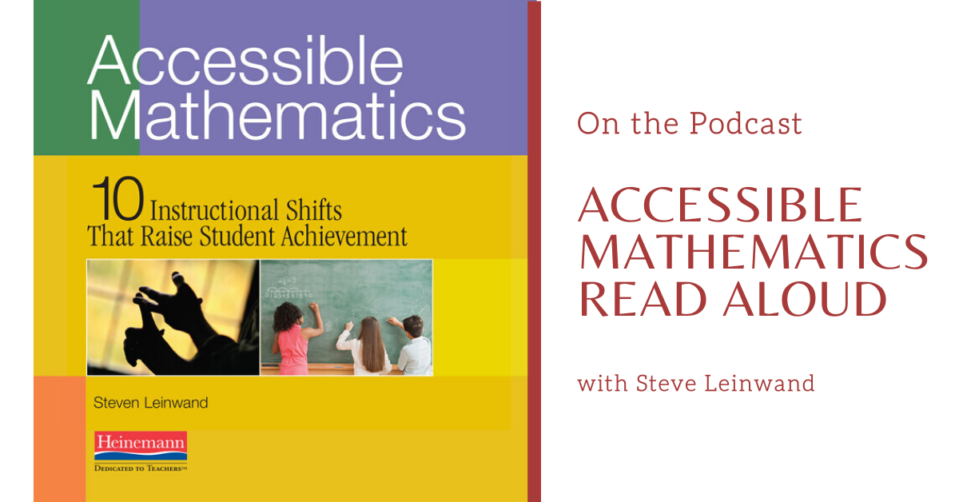
This week we’re excited to listen in on a preview of one of Heinemann’s newest audiobooks.
In Accessible Mathematics: Ten Instructional Shifts That Raise Student Achievement, author Steven Leinwand shows how small shifts in the teaching you already do can make a big difference in student learning.
Thoroughly practical and ever-aware of the limits of teachers’ time, Steve gives you his commonsense ideas to use immediately. His extensive planning advice will help you streamline your teaching to get more from everything you do. Classroom examples from every grade level model teaching language and instructional shifts.
In this preview of his audiobook, Steve talks about the impacts of not being taught math in an accessible way, and the importance of taking a varied approach to instruction.
Download Accessible Math from your favorite audio book provider!
Audible · Chirp · Apple Audiobooks · Google Play
Read along with Steve with a full transcript of chapter one below!
Walk into a kindergarten or first-grade classroom. You’re likely to see kids actively engaged, often in play, learning by doing, and sponging up knowledge. They learn about shapes by seeing them all around their classroom. They name and refer to these shapes naturally and in context—not just in Chapter 7. They use materials to join and separate sets in ways that concretize numbers and operations. It’s no surprise that, mathematically speaking, kindergarten and first-grade students tend to be a whole lot more successful than students
in any other grades.
Look at typical reading instruction. In a large proportion of reading lessons, literal comprehension is nearly always extended to inferential and evaluative comprehension via a systematic progression of questions. As we’ll explore in Chapter 3, it’s not a surprise that for
many students, reading is a far more positive, and more successful, experience than mathematics. Then wander into the gifted classroom and observe the questioning, the focus on reasoning, the frequent use of “Why?” and the attention paid to alternative approaches. It doesn’t take much imagination to recognize the chasm between standard operating procedure in most gifted classes and the worksheet-driven, procedure-oriented drudgery that typically passes for mathematics instruction in the remedial class down the hall. In fact, stroll down the corridor of nearly any school, and you have an immediate sense of which classrooms you would hope your own children would be in.
These are the active classes, the questioning classes, the thinking and reasoning classes where students are mentally, and even physically, engaged in the tasks at hand. You can feel the minds-on behaviors and sense the learning going on. And when we look deeper at what explains this engagement and this enhanced learning, whether in first grade or in a reading lesson or a gifted class, we can identify a clear pattern of instructional practices and behaviors that account for this success.
In other words, we know that there are places throughout the educational system where things tend to work consistently better than they do for mathematics. If this is the case, it becomes our job to identify and extract the specific strategies that are used in these successful places and experiences and to ensure that they are employed broadly and regularly to raise achievement, to improve instruction, and to make a difference in mathematics instruction for kids.
None of this is news. When instruction is traditional, rule-oriented teaching by telling and is devoid of number sense, we shouldn’t be surprised when students announce that the 5% tax on a $12 shirt is $60. Alan Schoenfeld describes relating to students that a shepherd
was guarding his flock of 18 sheep when all of a sudden 4 wolves came over the mountain. He then asks them, “How old is the shepherd?” This tends to evoke such appropriate answers as “Who knows?” and “That’s silly!” from the majority of first graders and the depressing answer “22” from the majority of sixth graders. We do not need any more
compelling evidence that something is seriously amiss. It is clear that for many students, thinking, reasoning, and sense-making are systematically exorcized from teaching because the primary focus in too many classrooms is a mindless emphasis on the one right way to get the one right answer to yet another decontextualized exercise.
Indeed, there are several ways to teach mathematics. We can demonstrate, tell, and let our students practice, or we can engage and focus on understanding and application. Nowhere is the traditional approach more succinctly presented than in Everybody Counts, the 1989 epic “Report to the Nation on the Future of Mathematics Education” from the National Research Council, where we are reminded that:
"evidence from many sources shows that the least effective mode for mathematics learning is the one that prevails in most of America’s classrooms: lecturing and listening. Despite daily homework, for most students and most teachers mathematics continues to be primarily a passive activity: teachers prescribe; students transcribe. Students simply do not retain for long what they learn by imitation from lectures, worksheets, or routine homework. Presentation and repetition help students do well on standardized tests and lower-order skills, but they are generally ineffective as teaching strategies for long-term learning, for highorder thinking, and for versatile problem-solving." (57)
Nowhere are the differences in how we might teach mathematics clearer than in the findings of the TIMSS video study. In the original work, Jim Stigler and his colleagues videotaped one hundred randomly chosen eighth-grade classes in the United States, Germany, and Japan. The analysis of these videos revealed two very different cultural scripts for what typically takes place in a mathematics classroom. Not surprisingly, in the United States and Germany, the focus was on skill acquisition and the typical class proceeded as follows:
- The teacher instructs students in a concept or skill.
- The teacher solves example problems with the class.
- The students practice on their own while the teacher assists
individual students.
Interestingly, in Japan, one finds a very different cultural script—not necessary a better script, but certainly different. In this case, the focus was on understanding and the typical class unfolded this
way:
- The teacher poses a complex, thought-provoking problem.
- Students struggle with the problem.
- Various students present ideas or solutions to the class.
- The class discusses the various solution methods.
- The teacher summarizes the class’ conclusions.
- The students practice similar problems.
If the traditional American mathematics classroom script is working for only about half of our students, one answer is to vary our approach. We are quick to acknowledge that our students come to us with incredibly diverse backgrounds, interests, and learning styles, but so often they are met with one monolithic approach best characterized as lecture and practice. It seems sensible that one way to address the diversity of our students is with greater diversity in our instructional practices. This diversity of practice implies variation in our approaches, alternative approaches to solving problems and thinking through the mathematics, and a richness of questioning that stimulates these alternatives and this thinking.
The sad reality is that our critics are not all wrong. For too long and for too many students the typical outcomes of school mathematics are mountains of math anxiety, tons of mathematical illiteracy, mediocre test scores, gobs of wasteful remediation, and a slew of entirely warranted criticism. This is not a pretty picture and is very hard to defensively dismiss. But the good news is that we know more than enough to avoid these outcomes. The better news is that we have sensible and accessible solutions. And the best news is that
overcoming the obstacles to implementing these solutions does not require more money or expensive interventions, or numerous days of professional development, or more courses in mathematics content. The primary obstacle is a lack of direction and a lack of will to make a few powerful instructional shifts in how we plan, implement, and assess daily mathematics instruction. In short, the answers lie in narrowing the chasm between what we know and what we do!
What exactly are these shifts? I’ve identified ten that capture much of what I have observed and that appear to work.
- Incorporate ongoing cumulative review into every day’s lesson.
- Adapt what we know works in our reading programs and apply it
to mathematics instruction. - Use multiple representations of mathematical entities.
- Create language-rich classroom routines.
- Take every available opportunity to support the development of
number sense. - Build from graphs, charts, and tables.
- Tie the math to such questions as How big? How much? How far? to increase the natural use of measurement throughout the curriculum.
- Minimize what is no longer important, and teach what is important when it is appropriate to do so.
- Embed the mathematics in realistic problems and real-world contexts.
- Make “Why?” “How do you know?” “Can you explain?” classroom
mantras.
Shifts 1, 2, and 10 focus broadly on review, discourse, and stimulating a depth of understanding. Shifts 3, 4, and 5 address the use of representations, communication, and number sense—three critical domains for accessing and demonstrating mathematical understanding. Shifts 6, 7, and 9 ground the mathematics in the world in which we live and build understanding from data and measurement that apply key mathematical ideas. Finally, shift 8 reminds us that we can’t do it all. Taken together, these ten strategies or shifts in how we plan, implement, and assess our mathematics instruction represent a road
map for significantly enhancing the quality of our teaching and its impact on student achievement.
…
Learn more about Accessible Mathematics at Heinemann.com
 Steve Leinwand
Steve Leinwand

